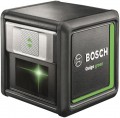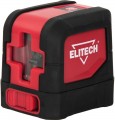Measurement range
The range at which the device remains fully operational without the use of additional receivers (see below); in other words, the radius of its action without auxiliary devices.
In some models, a range may be specified that shows the minimum (
3 cm,
5 cm) and maximum measurement ranges. But in most cases, only the maximum value is indicated.
The specific meaning of this parameter is determined by the type of instrument (see above). So, for optical levels, the measurement range is the greatest distance at which the operator can normally see the divisions of a standard leveling staff. For laser levels, this parameter determines the distance from the device to the surface on which the mark is projected, at which this projection will be easily visible to the naked eye; and in rangefinders we are talking about the greatest distance that can be measured. Typically, the measurement range is indicated for ideal conditions - in particular, in the absence of impurities in the air; in practice, it may be less due to dust, fog, or vice versa, bright sunlight "overlapping" the mark. At the same time, tools of the same type can be compared according to this characteristic.
Note that it is worth choosing a device according to the range of action, taking into account the features of the tasks that are planned to be solved with its help: after all, a large measurement range usually significa
...ntly affects the dimensions, weight, power consumption and price, but it is far from always required. For example, it hardly makes sense to look for a powerful laser level at 30-40 m if you need a device for finishing work in standard apartments.Accuracy
Accuracy is described as the maximum deviation from the true value of the measured parameter, which the device can give if all the rules for its operation and the corresponding measurements are observed. In both rangefinders and levels, this parameter is usually designated for a certain distance — for example, 3 mm at 30 m; but even for one manufacturer, these "control" distances may be different. Therefore, in our catalog, the accuracy of all devices is recalculated for 1 m distance; with such a record, for the example above, it will be 3/30 \u003d 0.1 mm / m. This makes it easier to compare different models with each other.
It is also worth mentioning that the meaning of the "accuracy" parameter for different types of measuring instruments (see "Type") will be different. For optical levels, it is described in the "SKP" paragraph above. For laser levels of all types, accuracy is the maximum deviation of the mark from the true horizontal (or vertical, if such a function is provided), and for the horizontal, we can talk about both moving the mark up / down and turning it. In rangefinders, this characteristic describes the maximum difference (both in "plus" and "minus") between the readings of the device and the actual distance to the object.
Anyway, the smaller the error, the better; on the other hand, accuracy significantly affects the price of the device. Therefore, it is necessary to choose a specific model for this parameter, taking into account the...specifics of the planned work. For example, for a relatively simple repair in a residential apartment, a high-precision tool is unlikely to be required; and recommendations for more complex tasks can be found in specialized sources, ranging from expert advice to official instructions.
Leveling time
Approximate time it takes for the self-levelling mechanism to bring the level to a perfectly level position.
For more information on such a mechanism, see Self-Level Limits. And the actual time of its alignment directly depends on the actual deviation of the device from the horizontal. Therefore, in the characteristics, usually, the maximum alignment time is given — that is, for the situation when in the initial position the device is tilted to the maximum angle along both axes, longitudinal and transverse. Since the levels are far from being installed in this position, in fact the speed of bringing to the horizontal is often higher than the claimed one. Nevertheless, it makes sense to evaluate different models precisely according to the figures stated in the characteristics — they allow you to estimate the maximum amount of time that will have to be spent on alignment after the next movement of the device. As for specific indicators, they can vary from 1.5 – 2 s to 30 s.
Theoretically, the shorter the alignment time, the better, especially if there are large volumes of work ahead with frequent movements from place to place. However, in fact, when comparing different models, it is worth considering other points. First, we reiterate that the rate of leveling is highly dependent on the leveling limits; after all, the greater the deviation angles, the more time it usually takes for the mechanism to return the level to the horizontal. So, to directly compare w...ith each other in terms of the speed of self-leveling, it is mainly those devices in which the permissible deviation angles are the same or differ slightly. Secondly, when choosing, it is worth considering the specifics of the proposed work. So, if the device is to be used frequently on very uneven surfaces, then, for example, a model with a leveling time of 20 s and self-levelling limits of 6 ° will be a more reasonable choice than a device with a time of 5 s and limits of 2 °, since in In the second case, a lot of time will be spent on the initial (manual) installation of the device. And for more or less even horizontal planes, on the contrary, a faster device may be the best option.
Operating temperature
The temperature range at which the device is guaranteed to work for a sufficiently long time without failures, breakdowns and exceeding the measurement error specified in the characteristics. Note that we are talking primarily about the temperature of the device case, and it depends not only on the ambient temperature — for example, a tool left in the sun can overheat even in fairly cool weather.
In general, you should pay attention to this parameter when you are looking for a model for working outdoors, in unheated rooms and other places with conditions that are significantly different from indoor ones; in the first case, it makes sense to also make sure that there is dust and water protection (see "Protection class"). On the other hand, even relatively simple and "myopic" levels / rangefinders usually tolerate both heat and cold quite well.
Diode emission
The wavelength of the radiation emitted by the LED of the level or rangefinder; this parameter determines primarily the colour of the laser beam. The most widespread in modern models are LEDs with a wavelength of about 635 nm — at a relatively low cost, they provide bright red radiation, giving a well-visible projection. There are also green lasers, usually at 532 nm — the marks from them are even better visible, but such LEDs are quite expensive and rarely used. And radiation with a wave longer than 780 nm belongs to the infrared spectrum. Such a laser is invisible to the naked eye and is poorly suited for leveling, but it can be used in rangefinders — of course, with a viewfinder (see "Type" for more details).
Laser colour
The color of the laser beam emitted by the device.
Red lasers are the most popular in our time: they are relatively inexpensive, while they are quite effective and functional, and also quite noticeable on most surfaces. In turn,
green lasers are better visible to the human eye (with the same emitter power); however, they are noticeably more expensive than red ones, consume more energy and have a shorter service life, and therefore are much less common.
Blue lines are rarely seen in laser instruments. Their competitive advantage over traditional green and red lasers is their high brightness, which ensures excellent visibility of the beams on many surfaces, incl. when doing outdoor work.
In some devices, you can find two types of lasers at once - both red and green. As a rule, these are levels with several projections, where green is used to build planes, and red is used for point projections.
Beam angle (vertical)
The sweep angle in the vertical plane provided by the level emitter. If there are several such radiators (for example, on both sides of the case), this parameter is given for each of them separately.
The sweep angle is, in fact, the coverage angle, that is, the width of the sector captured by the emitter when the line is formed. The wider this angle, the more convenient the device is to use, the lower the likelihood that the device will have to be moved up and down to build a line. On the other hand, a larger sweep angle (at the same range) requires more power — and this, accordingly, affects the cost and power consumption.
Beam angle (horizontal)
The sweep angle in the horizontal plane provided by the level emitter. If there are several emitters, their total coverage angle is indicated here; a typical example of such devices are models for full 360 °, not related to rotation.
Actually, all rotary devices, by definition, provide a coverage of 360 °. Therefore, it is worth paying attention to this parameter in cases where we are talking about more traditional laser levels. And here it is worth considering that a larger coverage angle, on the one hand, can provide additional convenience, on the other hand, it increases the price and power consumption of the device. So when choosing, you should proceed from real needs; detailed recommendations on this subject can be found in special sources.
IP protection rating
The level of protection against harmful influences (in the first place — the penetration of foreign objects) that the body of the level / rangefinder provides in accordance with the IP standard. This standard describes two separate characteristics — protection against solid objects and against water. They are designated respectively by the first and second digit after the IP index; the higher the number, the higher the degree of protection.
Considering that levels and rangefinders usually have to work on construction sites where there is a lot of dust, the minimum level of protection against solid objects for such tools is the fifth. It allows some dust to get inside, but in such a way that it does not affect the performance of the device. The maximum level of dust resistance is 6, which implies complete protection from solid particles.
The second characteristic, protection against moisture, in levels and rangefinders is usually indicated starting from level 4. Officially, it provides protection "against spray from any direction", in fact this means that it can be used in moderate rain with strong winds — a useful point in that if the tool is to be used outdoors. Level 5 allows operation during storms and downpours, a device of the sixth class can withstand being hit by a wave, the seventh — a short-term immersion under water up to 1 m, and the eighth — even a long stay under water. However, for a conventional construction tool, too high water resistance i...s usually not required.
Actually, the most popular option in modern construction tools is the IP54 class: it is quite enough even for work in bad weather, while such cases are relatively inexpensive. There are also more protected models, but less often.
It is also worth noting that a certain level of dust and water protection in itself is usually provided even in devices that do not have an IP marking. The absence of this index does not necessarily mean the absence of protection — it only says that the case has not been officially certified according to the IP standard. But if you need an additional guarantee of reliability, you should still pay attention to certified options.

